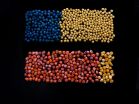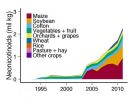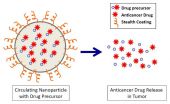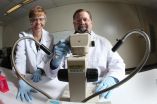INFORMATION:
The USDA's Northeast IPM Center supported this research.
Rapid increase in neonicotinoid insecticides driven by seed treatments
2015-04-02
(Press-News.org) Use of a class of insecticides, called neonicotinoids, increased dramatically in the mid-2000s and was driven almost entirely by the use of corn and soybean seeds treated with the pesticides, according to researchers at Penn State.
"Previous studies suggested that the percentage of corn acres treated with insecticides decreased during the 2000s, but once we took seed treatments into account we found the opposite pattern," said Margaret Douglas, graduate student in entomology. "Our results show that application of neonicotinoids to seed of corn and soybeans has driven a major surge in the U.S. cropland treated with insecticides since the mid-2000s."
According to Douglas, research suggests that neonicotinoids may harm pollinators. The European Union suspended neonicotioid use on bee-attractive crops and the U.S. Environmental Protection Agency is expediting their review.
After discovering that neonicotinoid seed treatments were not explicitly documented in U.S. government pesticide surveys, the researchers synthesized available information to characterize the widespread use of these insecticides. First they compiled pesticide data from two public sources -- the U.S. Geological Survey and the U.S. Department of Agriculture -- that both reported aspects of neonicotinoid use, but did not estimate seed treatment use specifically. Using these data, together with information from insecticide product labels, the team estimated the percentage of land planted in corn and soybeans in which neonicotinoid-treated seeds have been used since these products were introduced in the mid-2000s. They corroborated their results with information from the U.S. Environmental Protection Agency and DuPont Pioneer, a major seed supplier.
The team found that in 2000, less than 5 percent of soybean acres and less than 30 percent of corn acres were treated with an insecticide, but by 2011, at least a third of all soybean acres and at least 79 percent of all corn acres were planted with neonicotinoid-coated seed, constituting a significant expansion in insecticide use. The researchers also found that the vast majority of neonicotinoids are used on crops, rather than in other arenas such as people's homes or gardens, or in turf grass and ornamental settings. The results will appear today (Apr. 2,) in Environmental Science & Technology.
"Adoption of neonicotinoid insecticides by seed companies and farmers has been very rapid and does not appear to relate well to a corresponding risk from insect pests," said John Tooker, associate professor of entomology. "This pattern suggests that neonicotinoids are often being used as an 'insurance policy' against uncertain insect attack, rather than in response to a documented pest threat."
According to Douglas, the results inform an ongoing debate that is driven by detection of neonicotinoids in the environment and their possible negative effects on non-target animals, including wild and managed pollinators.
"Regulators, seed companies, farmers and the public are weighing the costs and benefits of neonicotinoid use," she said. "This debate has been happening in a void of basic information about when, where and how neonicotinoids are used. Our work is holding up a mirror so that this conversation can be informed by basic facts about neonicotinoid use."
In the future, the researchers plan to better document the prevalence of secondary insect pests targeted by seed treatments. They also will explore the unintended effects of neonicotinoid seed treatments on predatory insects that help to suppress insect pests. Finally, they are studying alternative management practices for early-season insect pests, for instance, using cover crops to reduce pest pressure and foster predatory insects.
ELSE PRESS RELEASES FROM THIS DATE:
Nanoparticles may exploit tumor weaknesses to selectively attack cancers
2015-04-02
Delving into the world of the extremely small, researchers are exploring how biodegradable nanoparticles can precisely deliver anticancer drugs to attack neuroblastoma, an often-deadly children's cancer.
By bringing together experts in pediatric oncology with experts in nanotechnology, researchers at The Children's Hospital of Philadelphia aim to thread the needle of delivering effective doses of cancer-killing agents while avoiding toxicity in healthy tissues. The team's new research shows that this approach inhibits tumor growth and markedly prolongs survival in animal ...
Physical activity benefits lung cancer patients and survivors
2015-04-02
DENVER - Exercise and physical activity should be considered as therapeutic options for lung cancer as they have been shown to reduce symptoms, increase exercise tolerance, improve quality of life, and potentially reduce length of hospital stay and complications following surgery for lung cancer.
Lung cancer is the leading cause of cancer deaths in the United States with an estimated 160,000 deaths each year and worldwide there are 1.4 million deaths. In the last two decades lung cancer therapy has improved, but the overall 5-year survival rate is still quite low at 17%. ...
Key mechanism identified in tumor-cell proliferation in pediatric bone cancers
2015-04-02
A particular molecular pathway permits stem cells in pediatric bone cancers to grow rapidly and aggressively, according to researchers at NYU Langone Medical Center and its Laura and Isaac Perlmutter Cancer Center.
In normal cell growth, the Hippo pathway, which controls organ size in animals, works as a dam, regulating cell proliferation. What the researchers found is that the transcription factor of a DNA binding protein called sex determining region Y box 2, or Sox2 for short, which normally maintains cell self-renewal, actually releases the floodgates in the Hippo ...
Witnessing drug problems or domestic violence causes greater asthma incidence
2015-04-02
ARLINGTON HEIGHTS, Ill. (April 2, 2015) - No home is perfect, but dysfunction in the home is now revealed to be especially dangerous for children at risk for asthma. A new study shows that children exposed to just one adverse childhood experience (ACE) had a 28 percent increased chance of developing asthma than those with no ACEs.
The study, published in the Annals of Allergy, Asthma and Immunology, the scientific publication of the American College of Allergy, Asthma and Immunology (ACAAI), used data from the National Survey of Children's Health. The survey drew from ...
Current residential development research is a poor foundation for sustainable development
2015-04-02
Globally, residential development is a leading driver of natural resource consumption, native species decline and fossil fuel emissions.
Today, residential development covers one out of every four acres of the land in the United States, and is predicted to more than double by 2100.
In many communities, local governments and planners are adopting sustainable development practices to address residential development impacts on human well-being and the environment. These sustainable development practices include considerations of a healthy environment, a robust economy, ...
Adults who struggle to follow heart medication regimens should focus on behavior change
2015-04-02
COLUMBIA, Mo. - Unlike some conditions, heart failure must be managed by patients taking prescriptions for the rest of their lives. Individuals who do not take their heart medication as prescribed have increased risks of mortality and hospitalization and higher health care costs. Numerous interventions have been designed to increase patients' adherence to medications; yet, no research has determined what intervention techniques are most effective. Now, a University of Missouri researcher found that interventions to encourage patients to take their medications as prescribed ...
New class of insecticides offers safer, more targeted mosquito control
2015-04-01
WEST LAFAYETTE, Ind. - Purdue researchers have identified a new class of chemical insecticides that could provide a safer, more selective means of controlling mosquitoes that transmit key infectious diseases such as dengue, yellow fever and elephantiasis.
Known as dopamine receptor antagonists, the chemicals beat out the neurotransmitter dopamine to lock into protein receptors that span the mosquito cell membrane. Disrupting the mechanics of dopamine - which plays important roles in cell signaling, movement, development and complex behaviors - eventually leads to the ...
NJIT mathematician's 2015 Major League Baseball projections
2015-04-01
The snow is almost gone in the northeast and that means baseball season cannot be far behind. Like most seasons, some teams look like they will continue to dominate their competition while others may spring some surprises. This is the 18th year that NJIT Mathematical Sciences Professor and Associate Dean Bruce Bukiet has published his model's projections of how the standings should look at the end of the regular season. Over the years, Bukiet has applied mathematical analysis to compute the number of regular season games each Major League Baseball team should win. Though ...
Study: Older workers bring valuable knowledge to the job
2015-04-01
WASHINGTON - In the workplace, age matters - but hiring or promoting based on age-related mental abilities can be a minefield, according to new research published by the American Psychological Association.
Older executives bring valuable skills to the job, such as higher "crystallized intelligence," which includes verbal ability and knowledge born of experience, according to a study published in APA's Journal of Applied Psychology. But compared with their younger counterparts, older executives show marked declines in "fluid intelligence," which involves the ability to ...
Locking up an oncogenic transcription
2015-04-01
WORCESTER, MA - A novel molecule designed by scientists at the University of Massachusetts Medical School and the University of Virginia inhibits progression of a hard-to-treat form of recurring acute myeloid leukemia (AML) in patient tissue. The small molecule is one of the first designed to specifically target a cancer-causing transcription factor. Previously thought to be an undruggable target, this strategy may be used to design other novel molecules that can specifically inhibit cancer-causing transcription factors. Details of the work were published in Science.
Transcription ...





